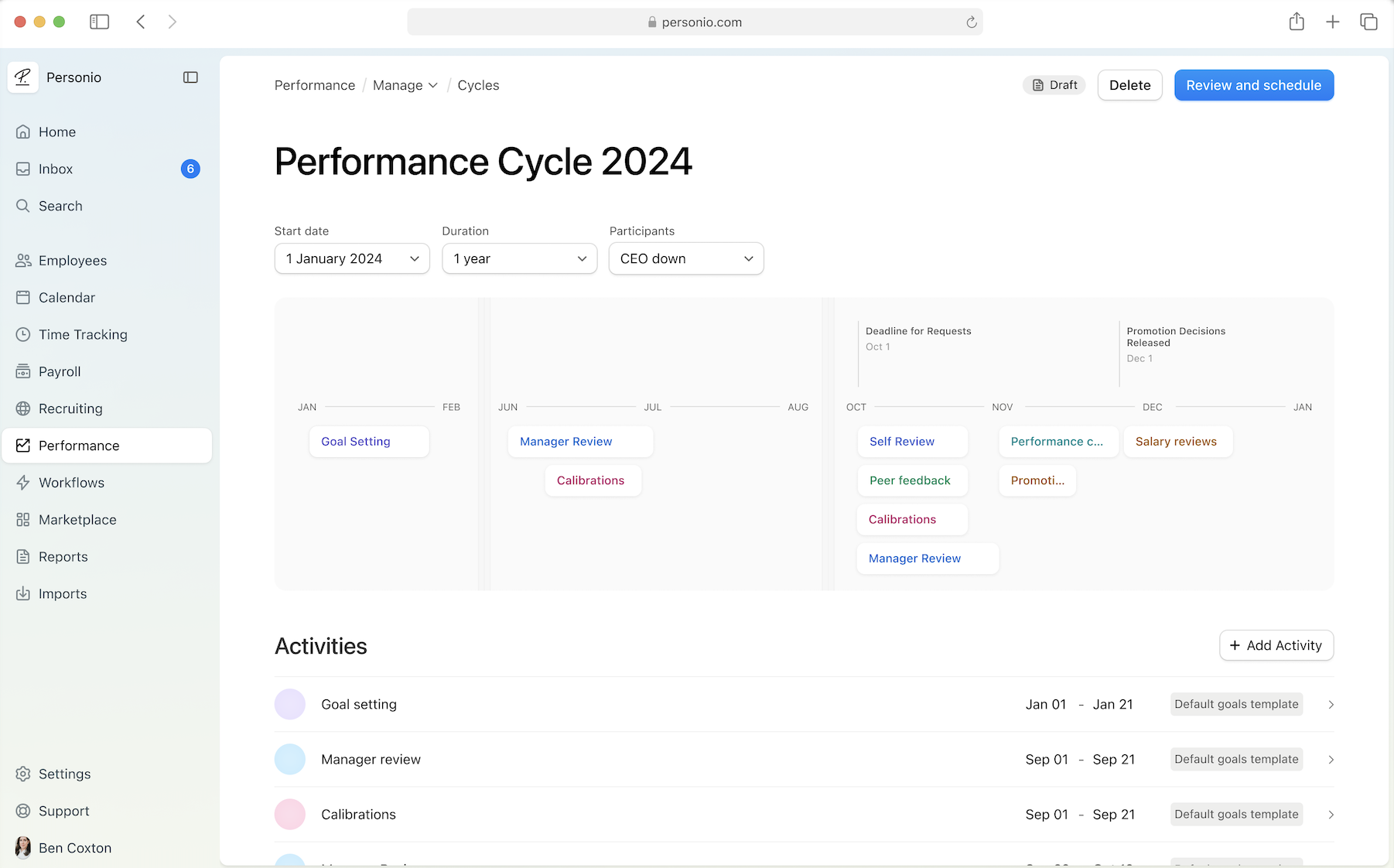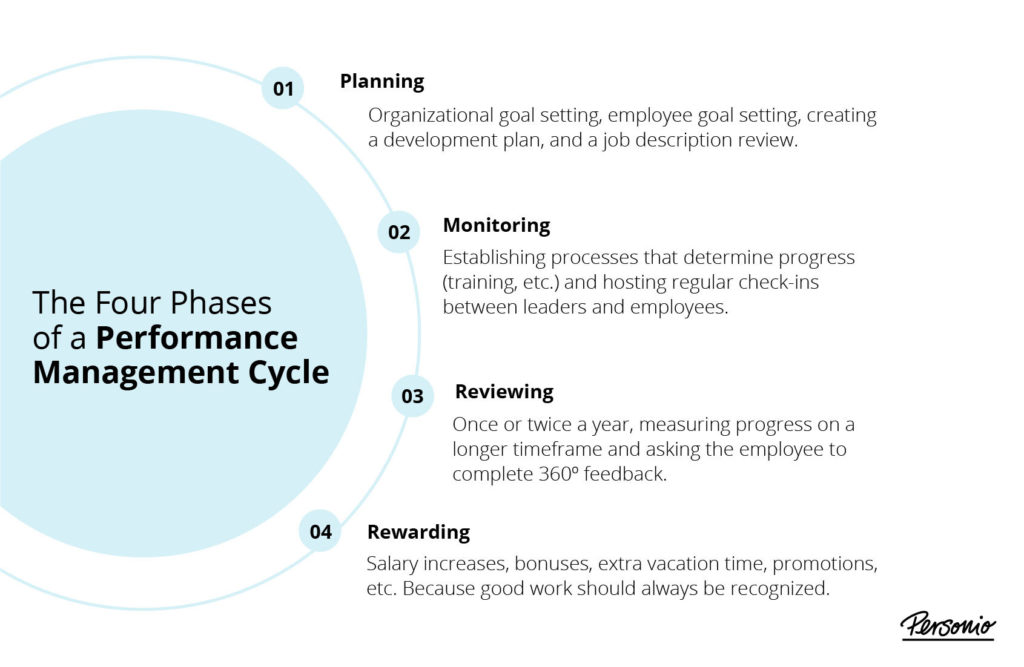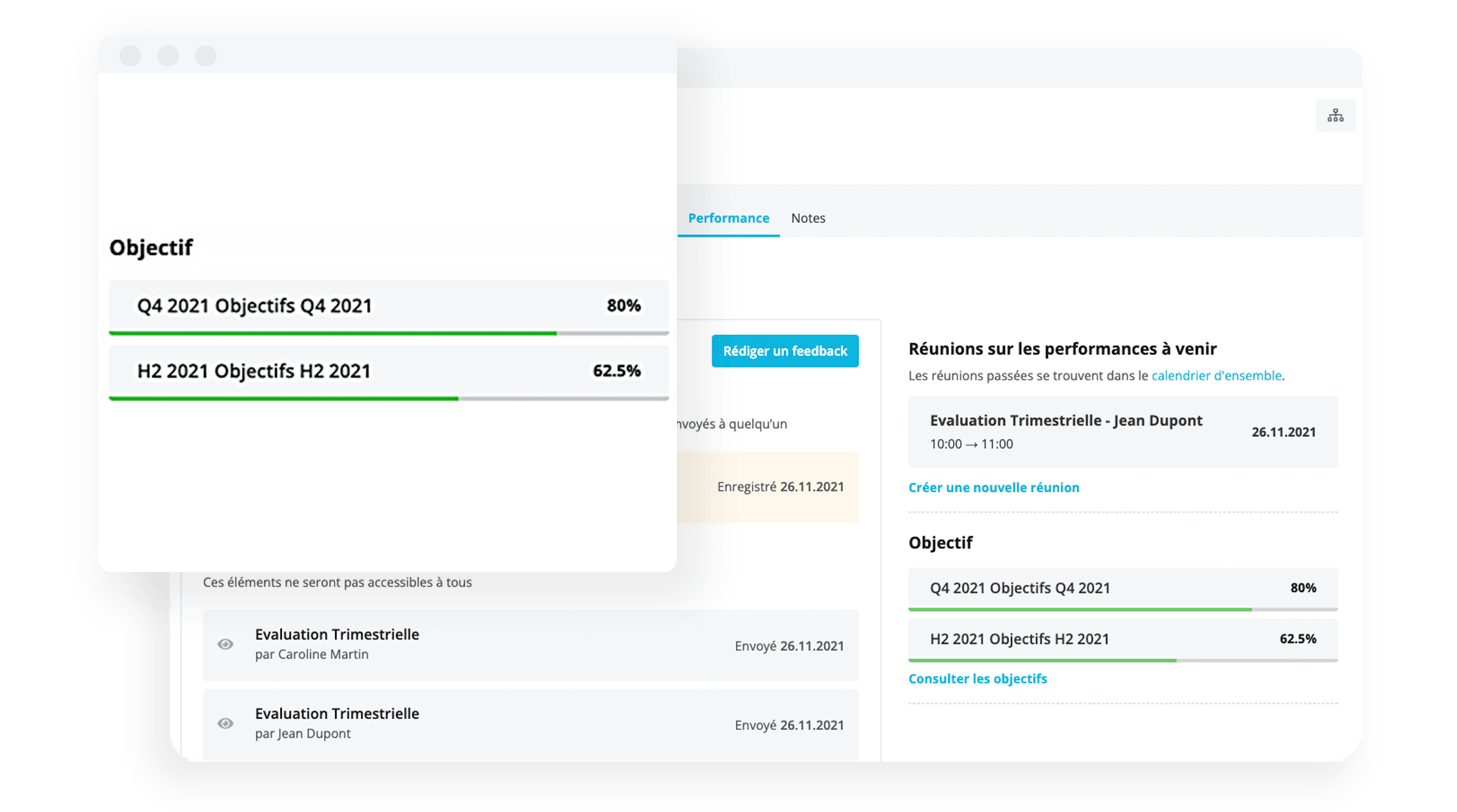
Revolutionise your processes
Check out the leading performance review software solutions to transform your workplace evaluations.
Read our guidePerformance Management Process & Cycles: A Comprehensive Guide

Performance management is crucial for maximising organisational value through effective employee management. But managing performance across an entire company involves handling processes, cycles, techniques and various other considerations.
In this guide, we dive into all aspects of performance management. We detail the processes and how to build a winning performance management cycle for your unique organisation.
Start things off strong by downloading our performance review template today.Contents
- 1What is performance management?
- 2What is the performance management process?
- 3Defining and measuring performance
- 4Objective setting
- 5Performance reviews
- 6Performance-related pay
- 7Whose role is performance management?
- 8Principles of good performance management
- 9The performance management cycle
- 10Phase one: Planning
- 11Phase two: Monitoring
- 12Phase three: Reviewing
- 13Phase four:
- 14Performance management best practices
- 15Challenges in performance management
- 16The role of technology in performance management
- 17Boost your organisational performance today
- 18Additional resources
What is performance management?
Performance management is a set of processes and standards that seek to manage, evaluate and guide an employee's performance at an organisation. This could include helping employees improve in their day-to-day work, work on their key skills, recover from a low point or continuously develop in a meaningful way.
As it happens, 46% of organisations have altered or modified their performance management systems, showcasing the importance of performance management in both delivering and maximising organisational value.
How? Performance management can deliver a higher return on investment by focusing on the following:
Training and developing your talent
Improving relationships between employees and line managers
Standardising processes to deliver consistency and transparency
Establishing a high-performance corporate culture
What is the performance management process?

The performance management process involves planning, monitoring, developing, rating and rewarding employees to maximise the value that they create. It is a holistic approach that involves a variety of practices aimed at maintaining and improving performance.
As part of this, performance management is most often delivered on a continuous and cyclical basis. This is often termed a 'performance management cycle,' which is a defined period of time where performance is rated, evaluated and rewarded accordingly.
Defining and measuring performance
Clear objectives and key performance indicators (KPIs) are essential for effective performance management. Performance can be categorised into three main types:
Task performance: This refers to the core job responsibilities and duties that an employee is hired to perform. It includes the technical aspects of a job, such as completing tasks accurately and efficiently.
Contextual performance: This involves behaviours that contribute to the organisational environment, such as teamwork, communication and supporting colleagues. These actions may not be part of the job description but are crucial for culture.
Adaptive performance: This is the ability to adjust to changes in the workplace, such as new technologies, processes or unexpected challenges. It reflects an employee's flexibility, resilience and problem-solving skills.
Aligning performance measures with organisational strategy ensures relevance and reliability. However, measuring performance for knowledge workers can be challenging due to the intangible nature of their outputs.
Objective setting
Setting objectives is key to improving performance. Effective objectives include SMART goals (Specific, Measurable, Achievable, Realistic, Timely), learning outcomes and behaviour-focused goals.
Strategies for effective goal setting:
Align individual and team objectives with organisational goals.
Use the SMART framework or alternative approaches.
Ensure objectives are clear, achievable and relevant.
Performance reviews
Performance reviews assess and improve employee performance. There is a shift towards more regular reviews and high-quality conversations over traditional annual appraisals.
Best practices for performance reviews:
Conduct continuous performance management for ongoing feedback.
Focus on developmental and future-focused discussions.
Use structured templates to standardise the review process.
Performance-related pay
Linking pay to performance can motivate employees but also has potential drawbacks. Fair and motivating reward systems are essential to avoid unintended consequences.
Best practices for performance-related pay:
Ensure transparency and fairness in the reward system.
Use a combination of salary increases, bonuses and other incentives.
Recognise and reward performance in a timely manner.
Whose role is performance management?
Performance management is a shared responsibility between people managers and HR. A supportive culture and climate that encourages regular performance discussions and continuous improvement are vital.
Key roles:
Managers: Link organisational and individual objectives, provide feedback and support.
HR: Develop effective practices and provide necessary tools and resources.
Principles of good performance management
Effective performance management is continuous, flexible and aligned with organisational priorities. Regular feedback and review of employee objectives are essential.
Key principles:
Continuous cycle: Performance management should be an ongoing process.
Flexibility: Adapt to changing needs and circumstances.
Alignment: Ensure objectives are in line with organisational goals.
The performance management cycle

The performance management cycle consists of four key stages: planning, monitoring, reviewing and rewarding. Each stage plays a crucial role in maintaining effective performance management...
Phase | Key Component |
|---|---|
Planning | Organisational and employee goal setting. |
Monitoring | Hosting check-ins and keeping on top of KPIs. |
Reviewing | Measuring progress on a yearly or biannual timeframe. |
Rewarding | Salary increases and other rewards to retain top talent. |
Phase one: Planning
The planning phase is the foundation of the performance management cycle. It involves setting organisational and employee goals, creating development plans and reviewing job descriptions.
Organisational goal setting

Organisational leadership needs to establish goals and objectives for the period covering a performance management cycle, typically a year or half-year. This alignment ensures that all team and employee goals contribute to the overall vision and objectives of the company.
Employee goal setting
Managers and employees work together to set individual performance goals. Using frameworks like SMART (Specific, Measurable, Achievable, Realistic, Timely) ensures goals are clear and achievable. Goals should allow employees to improve existing skills and develop new ones, aligning with the company’s objectives.
Creating a development plan
Once goals are set, a personal development plan is created, outlining the skills, knowledge and behaviours an employee needs to achieve their goals. This may include training, mentorship or other development activities. The plan should also consider the employee’s career aspirations.
Job description review
Reviewing and updating job descriptions ensures they accurately reflect the employee’s responsibilities and align with the set goals. This step helps clarify expectations and provides a clear framework for performance evaluation.
Phase two: Monitoring

Monitoring is the phase where employees actively work towards their goals. It involves regular check-ins, providing resources and support, and tracking progress.
Conducting effective check-ins
Regular check-ins, ideally monthly, help monitor progress and address any issues early. These meetings should focus on accomplishments, progress, roadblocks, changes and support needed. Effective check-ins prevent micromanagement and ensure goals are on track.
Providing resources and support
Managers must ensure employees have the necessary resources and support to achieve their goals. This includes access to training, tools and any other support required for their development.
Identifying and addressing potential problems
Early identification of potential problems allows for timely intervention. Managers should be proactive in addressing issues that may hinder progress, ensuring employees stay on track to meet their objectives.Some businesses prefer to call this phase "Acting” or “Performing.” That is because it is essentially the period in which employees are actively working on their goals as part of their day-to-day tasks.
During this phase of the performance management cycle, an employee also takes on some kind of training. Or, they undergo other parts of the development plan for the period.
Part of the manager’s role, then, is to ensure that support and resources are available. This is to enable the employee to carry out the work according to the plan.
An equally important management responsibility here is to do regular check-ins with the employee – ideally monthly — to monitor progress.
This isn’t micromanaging but ensuring that the goal can be achieved within the targeted time frame. In addition, identifying potential problems before it is too late.
Phase three: Reviewing

Reviewing is a comprehensive assessment of an employee’s performance, typically conducted once or twice a year. It involves evaluating progress, providing feedback and discussing future development opportunities.
Performance assessments
Performance assessments should include self-assessment, peer feedback and manager evaluations. This holistic approach provides a well-rounded view of the employee’s performance.
Feedback sessions
Feedback sessions should be constructive and focus on both achievements and areas for improvement. These discussions should be two-way, allowing employees to provide feedback on their experience and support received.
Discussing future development opportunities
Reviews should also focus on future development, identifying new goals and opportunities for growth. This forward-looking approach helps employees stay motivated and aligned with organisational objectives.
Try our performance review template on for size

Help your line managers host more productive check-in conversations with our performance review template. Create a standardised approach to how you introduce, discuss and rate performance. Try it today.
Grab my copy nowPhase four: Rewarding
Recognising and rewarding good performance is crucial for maintaining motivation and engagement. Rewards should be meaningful and directly tied to performance.
Methods of rewarding employees
Common methods include salary increases, bonuses, public recognition, extra vacation time, special programmes or projects and promotions. Rewards should be timely and reflect the employee’s contributions.
Best practices for meaningful rewards
Ensure rewards are fair and transparent. Tailor rewards to individual preferences where possible, and ensure they align with the company’s values and objectives.
Performance management best practices
Implementing an effective performance management cycle requires actionable tips and best practices.
Strategies for effective implementation:
Ensure leadership support and consistent application.
Use technology to enhance the process.
Foster a culture of continuous improvement.
Challenges in performance management
Common challenges in performance management include unfair or inaccurate systems, box-ticking exercises and outdated methods.
Solutions:
Continuously improve and adapt the system.
Ensure fairness and accuracy in performance evaluations.
Avoid turning the process into a mere formality.
The role of technology in performance management

Technology can enhance the performance management process by streamlining processes, improving accuracy and facilitating continuous management.
Benefits of technology:
Use performance management tools and software.
Improve accuracy and efficiency.
Facilitate continuous feedback and development.
Boost your organisational performance today
A structured and continuous performance management process is essential for organisational success. HR managers and leaders should adopt best practices and leverage technology for optimal results.
Key takeaways:
Performance management maximises organisational value.
Continuous and flexible approaches are crucial.
Technology enhances the process and ensures continuous improvement.
Speak with a Personio expert or kick off your own free trial to see how our all-in-one HR software can optimise your performance practices today.
Additional resources
For further reading and tools to implement effective performance management systems, explore our additional resources. Download templates and tools to help HR managers streamline the process and achieve better results.
Resources:
By following these guidelines, organisations can build a robust performance management system that drives employee development and organisational success.

